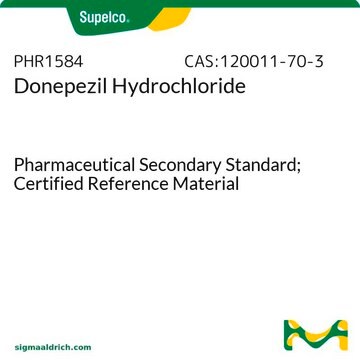S0929
Scopolamin -hydrobromid
meets USP testing specifications
Synonym(e):
(−)-Scopolamin -hydrobromid Trihydrat, Hyoscin -hydrobromid, Scopin-tropat
About This Item
Empfohlene Produkte
Agentur
USP/NF
meets USP testing specifications
Qualitätsniveau
mp (Schmelzpunkt)
195-199 °C (dry matter) (lit.)
Anwendung(en)
pharmaceutical (small molecule)
SMILES String
O.O.O.Br.CN1[C@@H]2C[C@H](C[C@H]1[C@@H]3O[C@H]23)OC(=O)[C@H](CO)c4ccccc4
InChI
1S/C17H21NO4.BrH.3H2O/c1-18-13-7-11(8-14(18)16-15(13)22-16)21-17(20)12(9-19)10-5-3-2-4-6-10;;;;/h2-6,11-16,19H,7-9H2,1H3;1H;3*1H2/t11-,12-,13-,14+,15-,16+;;;;/m1..../s1
InChIKey
LACQPOBCQQPVIT-SEYKEWMNSA-N
Angaben zum Gen
human ... CHRM1(1128)
Suchen Sie nach ähnlichen Produkten? Aufrufen Leitfaden zum Produktvergleich
Anwendung
- to reverse the cardiac effects of physostigmine in rabbit heart
- to study its effect on acoustic startle reflex (gap-PPI){148)
- to study it′s in vitro antiviral, antibacterial, and antifungal activities and cytotoxicity
- to study its effect on conditioning of lever pressing
Biochem./physiol. Wirkung
Signalwort
Danger
H-Sätze
Gefahreneinstufungen
Acute Tox. 1 Dermal - Acute Tox. 2 Inhalation - Acute Tox. 2 Oral
Lagerklassenschlüssel
6.1A - Combustible acute toxic Cat. 1 and 2 / very toxic hazardous materials
WGK
WGK 1
Flammpunkt (°F)
Not applicable
Flammpunkt (°C)
Not applicable
Persönliche Schutzausrüstung
Eyeshields, Faceshields, Gloves, type P3 (EN 143) respirator cartridges
Choose from one of the most recent versions:
Analysenzertifikate (COA)
Don't see the Right Version?
If you require a particular version, you can look up a specific certificate by the Lot or Batch number.
Besitzen Sie dieses Produkt bereits?
In der Dokumentenbibliothek finden Sie die Dokumentation zu den Produkten, die Sie kürzlich erworben haben.
Kunden haben sich ebenfalls angesehen
Unser Team von Wissenschaftlern verfügt über Erfahrung in allen Forschungsbereichen einschließlich Life Science, Materialwissenschaften, chemischer Synthese, Chromatographie, Analytik und vielen mehr..
Setzen Sie sich mit dem technischen Dienst in Verbindung.











